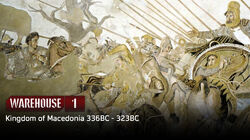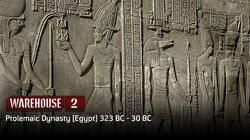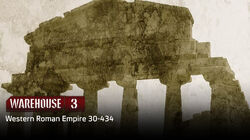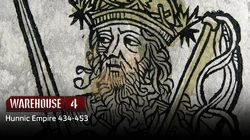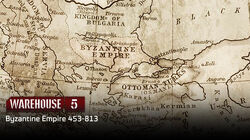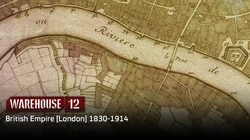The Warehouse is the global storage facility for artifacts. There have been thirteen official iterations of the Warehouse throughout history,[1] and the current one is Warehouse 13.
Description
TBA
Starting with an unknown iteration, presumably after Warehouse 2,[2] Hiram Abiff's Tools are used in the succession from one Warehouse to the next: the compass scans through the current Warehouse's inventory and converts all its artifacts into energy; in this form, they are transmitted to the mason square in the next Warehouse's chosen location to be converted back into their physical forms; this process is finalized when the setting maul is struck against the chosen location's cornerstone.[3]
Warehouse 1 (Greece)
Location: Kingdom of Macedonia[4]
Time Period: 336 BC - 323 BC
| “ | It was Alexander the Great who originally directed that a facility be designated to house and safe keep various artifacts that were collected during his war campaigns. He had just begun to establish his collection, when he succumbed to various illnesses and poisoning in 323 BC - possibly by an artifact, as the structure was built next to his residence. This lead to the building of the Library at Alexandria, and the next empire to protect the Warehouse... | ” |
The Minoan Trident was the first artifact to be stored by Alexander in "what would eventually become" Warehouse 1.[5]
Artifacts
Trivia
- In reality, Alexander the Great died in Babylon, Mesopotamia, not Macedonia.
Appearances
- Reset (mentioned)
Warehouse 2 (Egypt)
Location: Ptolemaic Dynasty (Valley of Alam Nafaza, Alexandria, Egypt)[6][7]
Time Period: 323 BC - 31 BC[7]
| “ | The beginning of a golden age, Warehouse 2 flourished under the Ptolemic Rulers, acquiring many Egyptian artifacts, including the skin from the asp that killed Cleopatra. It was under these first rulers that the Warehouse established its own system of rule and control, and a group of people from all walks of life was appointed to oversee it - The Regents. The Regents were the first actual "agents" of the Warehouse, and its first collectors of artifacts. Its residence in Egypt lasted until the suicide of Cleopatra, and the conquest of Egypt by Caesar and Rome. | ” |
When Egypt was defeated and conquered by Rome, the Regents of Warehouse 2 were not given enough time to find a new location to move to in advance and transfer the artifacts, forcing them to bury it under the desert sand so as to hide and preserve the artifacts while they set out to find the home of Warehouse 3.[7]
In 2010, it was reactivated by students on a secret trip to Egypt as paid by H.G. Wells to "discover" it. Wells' goal was to lure Warehouse 13 agents into Warehouse 2 and help her bypass the traps. Warehouse 2 required those who entered to pass three tests before they were safely inside. These tests challenged the mind, body, and soul, respectively. In the mind test, one is required to get rid of many large pegs by "jumping" them over each other until only one remains. In the body test, they must guide themselves through an obstacle course of fire and axes. Regent Benedict Valda died during this test. In the soul test, the agent has an illusion that they are in their happiest place, while in reality the floor is falling out from beneath them. Warehouse 2 attempted to form a connection with Irene Frederic, current Warehouse Caretaker, when it was reactivated. Warehouse 13 agents Pete, Myka, and Helena G. Wells were able to fully deactivate it. By unknown methods, most or all artifacts were sent to Warehouse 13 after they were buried under sand.[7]
Artifacts
- Anubus Shrine[8] (possibly)
- Bowl of Golden Apples[7]
- Minoan Trident (shaft)[5]
- Original Ten Tablets of Plato[7]
- Rod of Asclepius[7]
- Scarab of Imhotep[9]
- Skin of Cleopatra's Asp
- Cleopatra's Asp[10] (possibly)
- Socrates' Goblet
- Statue of Hera[9]
- Wings of Daedalus[5]
Trivia
- SyFy's website claims Warehouse 2 ended in 30 BC with the suicide of Cleopatra. This was later corrected in-show by Benedict Valda to 31 BC, the year of the Battle of Actium where the Egyptian empire was decidedly ended and the Roman Empire began, a year before Mark Antony's and Cleopatra's suicides.[7]
- The website also claims that the skin of the asp that killed Cleopatra was collected by Warehouse 2,[6] but she had committed suicide after Warehouse 2 was forced to close and move. The wording implies that the skin was collected because it was responsible for her death, but the skin may have been an artifact beforehand.
- The novel also claims that the asp itself, preserved, was also collected as an artifact. Theoretically, the asp itself may have been an artifact or otherwise anomalous, and both it and its skin were collected for having strange properties.[10]
Appearances
- Buried
- Reset
- The New Guy (mentioned)
- Queen For A Day (mentioned)
- Cangku Shisi (mentioned)
- Endless (pictured)
Warehouse 3 (Italy)
Location: Western Roman Empire[11]
Time Period: 31 BC[7] - 434 AD
| “ | The true flourishing of the Warehouse. The many rulers of the Roman Empire contributed tens of thousands of artifacts to the facility in the belief that it kept the empire safe and powerful. There may have been something to that, as they were in power for over 500 years. The sword that belonged to Marcus Aurelius that was ultimately used against him; the crucifix that belonged to Constantine the great - longest undisputed ruler of the entire Roman empire; the lyre that Nero played while Rome burned. Warehouse 3 resided in the Western Roman Empire until the rise of the Hunnic empire threatened Rome and Constantinople, and Attila the Hun appeared on the horizon. | ” |
Agents of Warehouse 3 were aware of a version of the Biblical story of Sodom's destruction at the hands of a windstorm burying it in the salt dunes that made the city so wealthy. They feared that the salt covering objects and taking their shape may have created several artifacts; one such artifact was a chunk of salt that had taken on the impression of a human face in agony.
By 2012, Janice Malloy had obtained the "salt mask" and was using it to exact revenge against people in her community she felt had betrayed her husband. In searching for artifacts relating to sin and punishment, Steve Jinks and Claudia Donovan searched through Warehouse files and discovered the obscure version of the Bible's recounting of Sodom's destruction and Warehouse 3's agents' fears.[12]
Artifacts
- Constantine the Great's Crucifix
- Marcus Aurelius (Marius)'s Sword
- Nero's Lyre (canonicity debatable)
Trivia
- SyFy's website claims that Nero's Lyre was among Warehouse 3's inventory, but this was later retconned in "Second Chance", where it was said to have been found in the ruins of the Domus Aurea, the building whose construction he began his infamous fire to clear land for, in 1866.[13]
- The Marcus Aurelius who died by his own sword is not the famed emperor (Marcus Aurelius Antoninus), but Marcus Aurelius Marius, an emperor of the Gallic Empire who lived approximately 100 years later, and whose reign only lasted between one and three months. According to legend, Marius was a blacksmith who became an officer of the army that revolted against their emperor when he refused to allow them to destroy a city as they wished. They murdered the emperor and elected Marius as his replacement, whose first decision was to allow his troops to sack the city as they planned. In ancient accounts, he was murdered only a mere two or three days into with a sword he himself had once forged.
Warehouse 4 (Huns)
Location: Hunnic Empire[14]
Time Period: 434 AD - 453 AD
| “ | Perhaps the shortest period of time the Warehouse has ever been located in a dynasty, Warehouse 4 was in Central Asia only until 453, when Attila died of a nosebleed on his wedding night. His sons vied for power, tribes rebelled, and the Warehouse moved back to the Eastern Roman, or Byzantine Empire. | ” |
Artifacts
- Attila the Hun's Helmet[15] (possibly)
Trivia
- No known capital of the Hunnic empire was ever clearly identified, making it one of the few Warehouses whose exact location is unknown.
Warehouse 5 (Byzantium)
Location: Byzantine Empire[16]
Time Period: 453 AD - 813 AD
| “ | Once back inside the Roman Empire, the Warehouse once again begins to fill its shelves with artifacts from around the world. It lasted inside these borders until the rise of Islam and the Iconoclasm controversies, filling entire sections of the Warehouse with religious icons and paraphernalia. After the loss of most remaining Italian territories, the Warehouse moves once again - this time across the continents. | ” |
Warehouse 6 (Cambodia)
Location: Khmer Empire (Angkor)[17]
Time Period: 813 AD - 1219 AD
| “ | In what is now Cambodia, the Warehouse located itself for over four centuries. Thousands of east Asian artifacts were collected over this period - many with ties to the reigning religions of the empire, Hinduism and Buddhism. The Warehouse was located in the city of Angkor, known to be the largest pre-industrial urban center in the world, larger than modern day New York and protected by the wealthiest and most powerful empire ever to reign in this region. It lasted here until the death of Jayavarman VII, and the Thai rebellions began, throwing the empire into a state of political instability, and necessitating a move. | ” |
Warehouse 6 introduced the Feng Shui Spiral, which is capable of reading the overwhelming emotion behind an artifact's creation to help shelve it properly.[18]
Appearances
- Parks and Rehabilitation (mentioned)
Warehouse 7 (Mongolia)
Location: Mongol Empire (Karakorum)[19][20]
Time Period: 1219 AD - 1260 AD
| “ | Spanning from Eastern Europe across Asia, the Mongol Empire was the largest contiguous empire in the history of the world. From the rule of the great Genghis Khan until the civil wars and unrest of Kublai Khan, the Warehouse benefited from the expanse of this empire and its collections of artifacts. But soon after the split, the Warehouse once again headed towards Rome. | ” |
At some point during the reign of Warehouse 7, Genghis Khan "went to great and terrible lengths" to create the Remati Shackle, an artifact capable of creating an impenetrable shield around the Warehouse, with the intent to keep it out of the hands of his enemies. The Shackle has been worn by and exchanged between the Regents ever since.[21]
At some point during its reign, a Regent Sanctum was created in Tai Po, Hong Kong, China. It functioned as a meeting place for the Regents of the time, as well as an escape route via portal should the forcefield created by the Remati Shackle trap people inside of the Warehouse. Although the Sanctum was later decommissioned, a space for its portal remains in Warehouse 13.[22]
Several hundred years later during the reign of Warehouse 12, the Regents of the time officially decommissioned the Sanctum. When they did so, they asked Caturanga to construct a special lock so that anyone who found the Sanctum would not easily be able to infiltrate the Warehouse and bypass the forcefield. Caturanga's lock, based on a game of chess, begins with the player in check. The player, locked in a chair, has three moves to win the game, with each move bringing a large blade closer to their head; if they do not solve the game in time, the player is killed. True to Caturanga's philosophy of changing the rules when one does not agree to them, the way to truly win the game is to break the conventional rules of chess and move pieces in illegal ways so as to place the opposing king in check. Winning the game releases the player and opens the portal to the Warehouse. This portal opens to whatever Warehouse currently reigns, such as Warehouse 13 rather than the decommissioned location of Warehouse 7.[22]
When a version of Benedict Valda from an alternate timeline escaped to the primary timeline, he attempted to decommission Warehouse 13 and instigate Warehouse 14 in China. The agents of Warehouse 13 went to stop him by taking the Regent Sanctum portal to Hong Kong.[3]
Artifacts
- Remati Shackle
- Genghis Khan's Mace[23] (possibly)
Appearances
- The 40th Floor (mentioned)
- Stand (mentioned)
Warehouse 8 (Germany)
Location: Holy Roman Empire (Berlin, Germany)[24][25]
Time Period: 1260 AD - 1517 AD
| “ | Actually encompassing Central Europe, the center of the HRE was in Germany - and so was the new home of Warehouse 8. By this time, the Regents of the Warehouse had learned over the centuries not to let its host empire to slip into decline before relocating. Signs of this decline became easier for the Regents to recognize, and so in 1517, when Martin Luther initiated what later became known as the Reformation, and after 250 years in Germany, the next move was again to the East. | ” |
In 2012, Claudia and Steve visit Warehouse 8 in order to find the dangerous Chinese Orchid, known for causing the deadly "sweating disease". Upon arrival, they find that an insurance firm has been built over Warehouse 8's original foundations and that the entrance is now located deep underground. After they find it, they discover the Warehouse is now nothing more than a small empty cave, only showing a clue as to the Orchid's location - a stone bridge over a river, indicating the artifact's guardians, the Steinbruck family.[25]
Artifacts
- Chinese Orchid[25]
- Leonardo da Vinci's Gargoyle[18]
- Leonardo da Vinci's Perpetual Motion Machine[26] (possibly)
Trivia
- Historically, the Holy Roman Empire had no set capital during its existence, but had various imperial seats. However, it is located in Berlin, the capital of modern Germany. It was established as the capital of Margraviate of Brandenburg, one of the HRE's major principalities in 1417.
- The series claims the Chinese Orchid was collected by agents of Warehouse 8 in 1551[25][27], when English Sweating Sickness disappeared in real history. However, Warehouse 8 ended in 1517, and it was instead Warehouse 9 that reigned by 1551.
Appearances
- We All Fall Down
- Parks and Rehabilitation (mentioned)
- Endless (logo featured)
Warehouse 9 (Turkey)
Location: Ottoman Empire (likely Constantinople/Istanbul)[28]
Time Period: 1517 AD - 1566 AD
| “ | Although the actual decline of the Ottoman Empire wouldn't be evident until the 1800s, the Warehouse was located here only during the reign of Suleiman the Magnificent. After his death, military and political stagnation indicated to the Regents of the time that a move would be prudent. | ” |
See page for further information.
Warehouse 10 (India)
Location: Mughal Empire (India)[29]
Time Period: 1566 AD - 1725 AD
| “ | By the height of their power (around 1700) the Mughals controlled most of the Indian subcontinent. During its residence in India at this time, the Taj Mahal was constructed, and the original plans for the structure are located in the Vitruvius Sector of the Warehouse. As British colonialism began to take advantage of the wars of succession that happened under the rule of Shah Alaam I, another move became imminent. | ” |
Artifacts
- Construction Plans of the Taj Mahal
- Miguel de Cervantes' Windmill[8]
- Don Quixote's Lance[8] (possibly)
Trivia
- Syfy notes that the end of the reign of Shah Alaam I signaled the power change prompting the Regents to move the Warehouse to its next location. Either the Shah's name is incorrect or the date is incorrect, though it is more likely the name, not the date. Shah Alaam I's fourth son, Muhammad Shah, was the emperor in power during the year the Warehouse was moved.
Appearances
- Grand Designs (mentioned)
- Endless Terror (logo featured)
- Endless (logo featured)
Warehouse 11 (Russia)
Location: Russian Empire (Moscow)[30]
Time Period: 1725 AD - 1830 AD
| “ | After Peter the Great consolidated the autocracy of Russia, and brought his empire into the European state system, the Regents moved the Warehouse to Moscow. For the first time, the Regents began to employ the use of agents who worked for the Warehouse, gathering artifacts and protecting the physical residence. By now, the Warehouse had grown to a very large collection, and more people were required to watch over it, and to travel the world in search of artifacts. Although Napoleon was unsuccessful in his attempt to overthrow Tsar Alexander I in 1812, the incident was enough to shake up the Regents, and after another 18 years, they decided to move the Warehouse once more - fortunately, many decades before the November uprising, and rebellion against the rule of the tsars. | ” |
Napoleon's efforts to conquer Russia were partially fueled by a desire to take control of the Warehouse. His attempts at claiming it involved directly attacking Regents, a method that would not be repeated until Walter Sykes' attacks in 2011.[21]
Charlotte Dupres ran into agent Alexei of this Warehouse, who killed her twice.[31]
Trivia
- Both Artie Nielsen and Benedict Valda state that Warehouse 2 had agents of its own (although as early Regents were also described as the "field agents of the time", this can be looked over).[32] Claudia Donovan says that the Chinese Orchid was collected by agents of Warehouse 8.[25] Charlotte Dupres and Bennett Sutton say that Paracelsus was apprehended and Bronzed by agents of Warehouse 9.[23] Pete Lattimer, Myka Bering, and Paracelsus encounter agents of Warehouse 9 when they travel back in time to 1541.[33]
Appearances
- The 40th Floor (mentioned)
- Lost & Found (mentioned)
- Endless Terror (logo featured)
- Endless (logo featured)
Warehouse 12 (Britain)
Location: British Empire (London, England)[34][35]
Time Period: 1830 AD - 1914 AD
| “ | Seeing the writing on the walls, the move to the British Empire proved to be the smartest one for the Warehouse since Alexandria. The introduction of working agents flourished under the Brits, and through the Imperialism of the British Empire, those agents were able to travel farther than ever before in their search for distant artifacts. Being at the center of the Industrial Revolution was also a boon to the Warehouse, letting it lead the way in the most state-of-the-art devices and upgrades. But then, with the assassination of Ferdinand, and the start of World War I, the next world power seemed clear. | ” |
See page for further information.
In a similar incident, as revealed in the Warehouse 13 Comic Book, the Warehouse 12 freighter HMS Halcyon was sunk off the Virginian coast after the attempted hijacking by three rebels sent by Confederate President Jefferson Davis, who knew of Warehouse 12 and the power of artifacts, in an attempt to use its contents to turn the tide of the Civil War in the South's favor; all three men chose the gallows over confession. One of the men, Bartholomew Adair, was an ancestor of Viola Adair, who would later find and release part of the Halcyon's artifact cache, attracting the attention of Warehouse agents, in an attempt to live up to her father's example and legacy by killing them.
Warehouse 13 (North America)
Location: North America (Univille, South Dakota, United States of America)
Time Period:
The 13th iteration of the Warehouse marks the first time in its history that the Regents actively chose not to move the Warehouse to the center of an empire. Instead, the Warehouse was located in a remote area of South Dakota, within the United States of America. Because of the lack of population and the amount of possible land available, this area was chosen not just for remoteness, but also for expansion possibilities. With the rise of Hitler in the 1940s, a briefly discussed plan to move the Warehouse back to Germany was quickly abandoned. Security was vastly increased at the Warehouse with the increase in spying that became prevalent during that time and during the height of World War II. To prevent foreign spies from accessing Warehouse secrets and provide a stealthy reason for the Warehouse's existence, the Regents began circulating the very well-kept rumor that the Warehouse structure contained tax returns for all United States citizens. Ostensibly the rumor was repugnant enough to the majority of people that it and the increased technological safety measures of the time have protected the Warehouse ever since.
Trivia
- Continuity note: When this wiki page was originally written, the creator took liberties with the information and did not copy SyFy's descriptions verbatim. SyFy's Warehouse History page has since been deleted, and no archives of the page include a visible description of Warehouse 13's history. As such, it cannot be determined if some information here, such as the brief discussion to move the Warehouse back to Germany or increasing security due to spying, are official or non-canon embellishments that merely extrapolate on real history. However, they will not be removed on the chance they may be official, so as to avoid that information being lost forever.
Warehouse 14 (China)

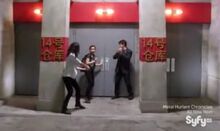
Location Beijing, China[3]
Time Period: 2014 AD (Temporary)
Also known as 'Cangku Shisi', thanks to the alternate reality version of Benedict Valda negotiating with the Chinese, utilizing Hiram Abiff's Tools, Warehouse 14 was originally to be installed beneath the Beijing Olympic Stadium. The facility was so far complete as to have nameplates on the walls and began to receive artifacts transferred through the Mason's Square.
Warehouse 14's status remains unknown as the effect of the Mason's Square was reversed and Warehouse 13 was shown to be in operation fifty years after the initial transfer and reversal of artifacts. Whether the same location will be used when the Warehouse eventually moves is also unknown.
Trivia
- TBA
Appearances
- Parks and Rehabilitation (mentioned)
- Cangku Shisi
- Endless (mentioned)
References
- ↑ https://web.archive.org/web/20131018030529/http://www.syfy.com/warehouse13/history
- ↑ The Warehouse is implied to have only started using these tools after the abandonment of Warehouse 2 and the establishment of Warehouse 3. It is shown in "Cangku Shisi" that the Compass can scan and convert the Warehouse's inventory through any obstacle, cannot be destroyed, and this process cannot be stopped unless the Setting Maul is dismantled before it strikes the cornerstone of the next Warehouse's location. It is explained in "Buried" When the Romans invaded Egypt to seize Warehouse 2, it was abandoned because there was "no time" to move its inventory, and thus it was buried to safeguard its contents.
- ↑ 3.0 3.1 3.2 Cangku Shisi
- ↑ https://web.archive.org/web/20131004215802/http://www.syfy.com/warehouse13/history/warehouse_1
- ↑ 5.0 5.1 5.2 5.3 Reset
- ↑ 6.0 6.1 https://web.archive.org/web/20131004215637/http://www.syfy.com/warehouse13/history/warehouse_2
- ↑ 7.0 7.1 7.2 7.3 7.4 7.5 7.6 7.7 7.8 "Buried"
- ↑ 8.0 8.1 8.2 Grand Designs
- ↑ 9.0 9.1 The New Guy
- ↑ 10.0 10.1 Warehouse 13: A Touch of Fever
- ↑ https://web.archive.org/web/20131005053022/http://www.syfy.com/warehouse13/history/warehouse_3
- ↑ What Matters Most
- ↑ Second Chance (see this image)
- ↑ https://web.archive.org/web/20131005052411/http://www.syfy.com/warehouse13/history/warehouse_4
- ↑ A Faire to Remember
- ↑ https://web.archive.org/web/20131005023900/http://www.syfy.com/warehouse13/history/warehouse_5
- ↑ https://web.archive.org/web/20131005092040/http://www.syfy.com/warehouse13/history/warehouse_6
- ↑ 18.0 18.1 Parks and Rehabilitation
- ↑ https://web.archive.org/web/20131005080908/http://www.syfy.com/warehouse13/history/warehouse_7
- ↑ "Hotel Mongolia" on Wikipedia
- ↑ 21.0 21.1 The 40th Floor
- ↑ 22.0 22.1 Stand
- ↑ 23.0 23.1 All the Time in the World
- ↑ https://web.archive.org/web/20131005071845/http://www.syfy.com/warehouse13/history/warehouse_8
- ↑ 25.0 25.1 25.2 25.3 25.4 We All Fall Down
- ↑ Of Monsters and Men
- ↑ The Living and the Dead
- ↑ https://web.archive.org/web/20131005083252/http://www.syfy.com/warehouse13/history/warehouse_9
- ↑ https://web.archive.org/web/20131005055325/http://www.syfy.com/warehouse13/history/warehouse_10
- ↑ https://web.archive.org/web/20131004215635/http://www.syfy.com/warehouse13/history/warehouse_11
- ↑ Lost & Found
- ↑ Buried
- ↑ Endless Terror
- ↑ https://web.archive.org/web/20131004215800/http://www.syfy.com/warehouse13/history/warehouse_12
- ↑ 3... 2... 1
- ↑ Pilot
- ↑ Endless (see this image)
